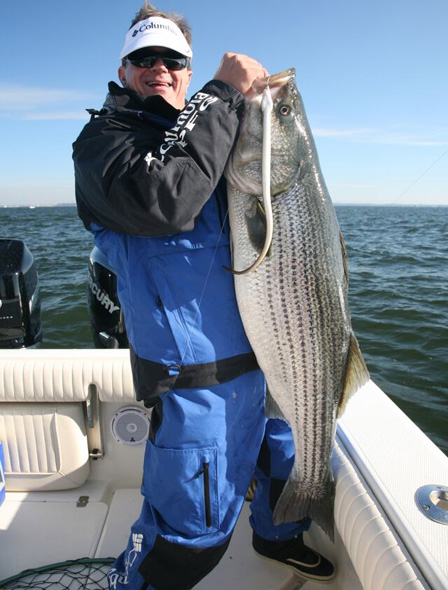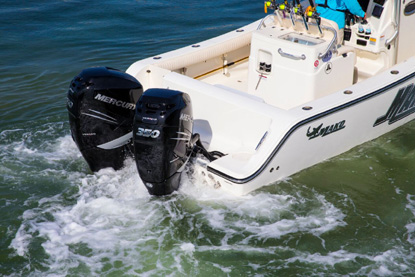It had been a tough night for Kevin Jeffries and me, losing three large Cubera snappers to a Key Largo, Florida Keys, wreck we were drifting over. Even with 80 and 100lb test braid stand up tackle, it’s nearly impossible to catch these monsters unless they’re located away from the wreck. So, adjustments were clearly in order.
The next evening, we marked Cuberas schooling between 170 and 190 feet, far from the wreck in 220 feet. We lowered live lobster baits, but had drifted past the school within minutes. After a few more quick and unsuccessful drifts past other Cubera schools, we finally modified our drift and kept above the next school by backing into and stemming the current. That extra soak time in the middle of the Cuberas was the ticket, as Kevin Jeffries rallied by catching two brutes during our trip.
.jpg)
SLOW THE PACE – Like our Cubera snapper outing, it’s often necessary to control your drift to score. When live bait kite fishing for sailfish, I’ll initially let wind and current dictate the drift pace. This is especially effective when fish are scattered, because more territory is covered, minus a drift anchor. However, with a fast current and moderate breeze - where baits are racing past depth contours, or, within an active zone, we’ll deploy a sea anchor and slow our pace; baits swim much longer in various zones, we’ve more precise placements of baits throughout the depths, and fragile baits - like ballyhoo, pilchards and cigar minnows, are much more active, as they rarely fare well at a fast clip. Naturally, when into fish, the boat remains over them longer.
Sea anchors also provide extra time to live bait or chunk along weedlines and rips for dolphin (they’re even occasionally attracted to the chute), over humps and wrecks for blackfin tuna, near canyons and eddies for tuna and swordfish, over schools of kings and Spanish mackerel, or deep jig along reefs and wrecks. In bays and sounds, you’ll drift slower over potentially-productive sea grasses and bottoms, and schooling fish – the likes of sea trout, striped bass, redfish and flounder.

KNOW THE DIFFERENCE – A drift anchor is intended primarily as a fishing aid, and is much smaller than a true sea anchor. To function, it requires just enough rode so it rises and falls in sync with the boat. Drag is created as its funnel shape catches and restricts the flow of water through its small opening, keeping the boat’s bow into the sea. It is retrieved by pulling on the trip line, and breaking this drag. Drift anchors are popular for small inshore and mid-size coastal boats.
The more expensive sea anchor, by comparison, is a safety device first and foremost. It must be approved by the USCG, as its primary function is to keep the bow of a disabled vessel into the seas, and save lives. The opened “parachute” catches water, the resistance of which swings the boat’ bow into the seas and slows its drift. For the same size vessel, a sea anchor will be several times larger than a drift anchor. Much more rode must also be paid out for it to function properly. Yet, pulling the trip line and retrieving the chute is not that cumbersome, so don’t be intimated.
Sea anchor style drift aids are popular aboard big center consoles, midsize and large offshore fishing boats which see a lot of live baiting and chunking. I’ve a 12-foot Para-Tech sea anchor, which dramatically slows my boat’s drift while simultaneously stabilizing it when we’re live baiting in a rough ocean.
SLOW HAND – Using the throttle(s) provides more precision than a drift anchor in shorter fishing confines - like over a wreck, or dropping on fish marked on the sonar – be it Cuberas, striped bass, bluefish, blackfin tuna, amberjack, etc.
When dropping on a wreck or school of fish, back into and stem the current. The amount of throttle and steering adjustments to hold in place will be dictated by current speed and any wind influence. More control and precision generally comes from reversing into a current. However, if rough, hold the bow into the current. Stemming the current enables jigs, live- and even cut baits to be lowered down to fish or structure, and kept there long enough to get noticed, compared to free drifting (minus sea anchor) where offerings may only hold briefly in a prime zone.
RIPS AND COLOR CHANGES - Stemming the current is common practice when live baiting for sailfish, dolphin, wahoo, and kingfish as well as cobia, striped bass, and bluefish. Given the amount of lines set out for pelagics and the likelihood of slow-trolling to cover ground, as well as remaining stationary, point the bow of the boat into the seas, and deploy baits off the transom. Edge the boat upwind/current of a rip or color change until the live baits are swimming along that edge; then use just enough throttle to stem the current and maneuver those baits along both sides of the edge. By working with any breeze, you can crab along the rip or color change and keep those baits advertising in prime territory.
INSHORE - When searching down-current sides of bridges for snook, tarpon or striped bass, ease into casting range by reversing into the tide and then stemming it. Fan cast at spots where fish are likely staging out of the current and ambushing bait sweeping by. Then, slowly throttle forward enough to make a slight adjustment over to the next set of pilings, slowly reverse back to a comfortable casting distance, and then stem the tide. Continue this tactic along the bridge span. On the up current side, stem the tide with the bow, and keep the anglers fishing from the cockpit. On the hook up (either side) throttle forward to help the angler keep a hard-charging fish from breaking off on a piling.
Sometimes, you just have to slow down to catch more. It can be that simple.
“NO-HANDS” CONTROLLED DRIFT TECHNOLOGY
I’ve discovered yet another fishing advantage, by playing around with the Skyhook Digital Anchoring System aboard my boat. This option from Mercury Marine uses GPS and its outboards to hold a boat in place, automatically. At the push of a button, the outboards, governed by GPS, work with and often against each other to maintain the boat’s position. This includes shifting and throttling. It’s a convenient feature while waiting for a bridge to open, or spot at a fuel dock or boat ramp. But, I’ve been using it to drop over wrecks, cast along bridges, and jig- and live bait sections of reef, before deciding if any are worthy enough to deploy the real anchor and sit on them for a bit. Plus, everyone can fish, as no one needs to be at the helm. The churning from the props in a hard current may even prompt curious fish – like cobia and amberjack, to rise from a deep wreck, and I’ve already used the system near weedlines to tease dolphin back to the boat.

BIG ADVANTAGES OF FISHING WITH DRIFT AND SEA ANCHORS
- Holds bow into the seas.
- Slows drift speeds from marginally to considerably, based on size and design.
- Stabilizes boat, for more comfortable fishing.
- More efficient bait presentation, due to stern facing downwind/current; lines generally lay straight back, enabling more to be fished.
- More precise deep bait deployments, often with less weight - compared to a fast drift minus sea anchor.
- More freedom for baits to swim; less current to whisk them along.
- A quieter presence, compared to power-drifting; good for “sliding” over schools of fish, or those run deep by heavy fishing pressure from power-drifters and trollers.
- Can be retrieved quickly to avoid a hooked fish running into it, or to give chase.
.jpg) |
TRUE SEA ANCHOR FACTS
- The general rule when selecting a sea anchor (not drift sock) is to choose one with a diameter that is double the draft of a mono hull boat (a boat with a draft of two feet will require a sea anchor with a four foot diameter).
- The sea anchor’s maximum strength in tons should equal its diameter in feet. That is, a four-foot sea anchor should withstand the pull of four tons. Consider your boat’s weight when choosing a sea anchor.
- The recommend amount of nylon rode deployed for a sea anchor should be based on doubling the wave height and multiplying by ten. For example, in a six foot sea, 120 feet of rode should be paid out (12 X 10). Because Dacron and polyester rodes have less stretch than nylon, double the wave height and multiply by 20 when using them (doing so provides an extra cushion, and less stress on the rode and anchor components). Note, this table is for safety deployment in a true emergency. For fishing deployments, and in non-threatening seas, less rode can be paid out.
ADVANTAGES OF POWER DRITING
- More precise for fishing smaller targets, i.e. wrecks, humps, ledges, etc., then drifting with a sea anchor.
- Maneuverability - latitude to cover ground by slow-trolling, then holding on or near a target by stemming the current.
- The option of throttling away from structure to keep a hooked fish, such as a large amberjack or grouper, off balance and from breaking off.
- The option of quickly throttling forward to help set the hook on a pelagic.
- Ability to “crab” along rips, color changes and bridges and thoroughly bait such structures by using any wind and small throttle adjustments.
- Aboard center consoles - unobstructed fish fighting space, with no concerns of pulling in a drift sock or sea anchor.

